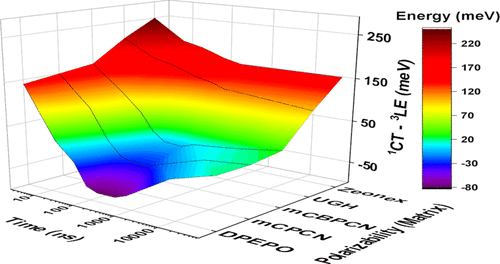当前位置:
X-MOL 学术
›
ACS Appl. Electron. Mater.
›
论文详情
Our official English website, www.x-mol.net, welcomes your
feedback! (Note: you will need to create a separate account there.)
Photophysics of TADF Guest–Host Systems: Introducing the Idea of Hosting Potential
ACS Applied Electronic Materials ( IF 4.3 ) Pub Date : 2020-08-10 , DOI: 10.1021/acsaelm.0c00514 Kleitos Stavrou 1 , Larissa G. Franca 1 , Andrew P. Monkman 1
ACS Applied Electronic Materials ( IF 4.3 ) Pub Date : 2020-08-10 , DOI: 10.1021/acsaelm.0c00514 Kleitos Stavrou 1 , Larissa G. Franca 1 , Andrew P. Monkman 1
Affiliation

|
The thermally activated delayed fluorescence (TADF) donor–acceptor (D–A) molecule, DMAC–TRZ, is used as a TADF emitter “probe” to distinguish the environmental effects of a range of solid-state host materials in guest–host systems. Using the guest’s photophysical behavior in solution as a benchmark, a comprehensive study using a variety of typical TADF organic light-emitting diode hosts with different characteristics provides a clearer understanding of guest–host interactions and what affects emitter performance in solid state. We investigate which are the key host characteristics that directly affect charge-transfer (CT) state energy and singlet triplet energy gaps. Using time-resolved photoluminescence measurements, we use the CT state energy distribution obtained from the full width at half-maximum (fwhm) of the emission band and correlate this with other photophysical properties such as the apparent dynamic red shift of CT emission on-set to estimate the disorder-induced heterogeneity of D–A dihedral angles and singlet triplet gaps. Further, the delayed emission stabilization energy value and time-dependent CT band fwhm are shown to be related to a combination of host’s rigidity, emitter molecule packing, and the energy difference between guest and host lowest energy triplet states. Concentration dependence studies show that emitter dimerization/aggregation can improve as well as reduce emission efficiency depending on the characteristics of the host. Two similar host materials, mCPCN and mCBPCN, with optimum host characteristics show completely different behaviors, and their hosting potential is extensively explored. We demonstrate that type I and type III TADF emitters behave differently in the same host and that the materials with intrinsic small ΔEST have the smallest disorder-induced CT energy and reverse intersystem crossing rate dispersion. We also present an optimized method to define the actual triplet energy of a guest–host system, a crucial parameter in understanding the overall mechanism of the TADF efficiency of the system.
中文翻译:

TADF来宾-宿主系统的光物理:引入潜在宿主的想法
热活化延迟荧光(TADF)供体-受体(D–A)分子DMAC–TRZ被用作TADF发射体“探针”,以区分客体-宿主系统中多种固态基质材料对环境的影响。以溶液中客体的光物理行为为基准,使用各种具有不同特性的典型TADF有机发光二极管主体进行的全面研究,可以更清晰地了解客体与主体之间的相互作用以及在固态下会影响发射极性能的因素。我们调查哪些是直接影响电荷转移(CT)状态能和单重态三重态能隙的关键宿主特征。使用时间分辨的光致发光测量,我们使用从发射带的半峰全宽(fwhm)获得的CT状态能量分布,并将其与其他光物理特性(如CT发射开始时的表观动态红移)相关联,以估计无序诱发的异质性D–A二面角和单重态三重态间隙。此外,延迟的发射稳定能值和随时间变化的CT带fwhm被显示与主体刚性,发射体分子堆积以及客体和主体最低能态三重态之间的能量差有关。浓度依赖性研究表明,取决于主体的特性,发射器二聚/聚集可以提高并降低发射效率。两种相似的宿主材料,mCPCN和mCBPCN,具有最佳宿主特征的宿主表现出完全不同的行为,并且对其宿主潜能进行了广泛的探索。我们证明了I型和III型TADF发射器在同一主体中的行为不同,并且具有固有小Δ的材料E ST具有最小的无序诱发CT能量和反向系统间交叉速率分散。我们还提出了一种优化的方法来定义来宾-主机系统的实际三重态能量,这是理解系统TADF效率的整体机制的关键参数。
更新日期:2020-09-22
中文翻译:

TADF来宾-宿主系统的光物理:引入潜在宿主的想法
热活化延迟荧光(TADF)供体-受体(D–A)分子DMAC–TRZ被用作TADF发射体“探针”,以区分客体-宿主系统中多种固态基质材料对环境的影响。以溶液中客体的光物理行为为基准,使用各种具有不同特性的典型TADF有机发光二极管主体进行的全面研究,可以更清晰地了解客体与主体之间的相互作用以及在固态下会影响发射极性能的因素。我们调查哪些是直接影响电荷转移(CT)状态能和单重态三重态能隙的关键宿主特征。使用时间分辨的光致发光测量,我们使用从发射带的半峰全宽(fwhm)获得的CT状态能量分布,并将其与其他光物理特性(如CT发射开始时的表观动态红移)相关联,以估计无序诱发的异质性D–A二面角和单重态三重态间隙。此外,延迟的发射稳定能值和随时间变化的CT带fwhm被显示与主体刚性,发射体分子堆积以及客体和主体最低能态三重态之间的能量差有关。浓度依赖性研究表明,取决于主体的特性,发射器二聚/聚集可以提高并降低发射效率。两种相似的宿主材料,mCPCN和mCBPCN,具有最佳宿主特征的宿主表现出完全不同的行为,并且对其宿主潜能进行了广泛的探索。我们证明了I型和III型TADF发射器在同一主体中的行为不同,并且具有固有小Δ的材料E ST具有最小的无序诱发CT能量和反向系统间交叉速率分散。我们还提出了一种优化的方法来定义来宾-主机系统的实际三重态能量,这是理解系统TADF效率的整体机制的关键参数。











































 京公网安备 11010802027423号
京公网安备 11010802027423号